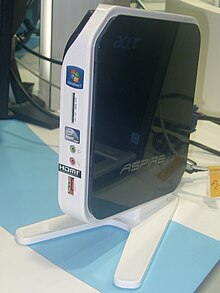

This article has multiple issues. Please help improve it or discuss these issues on the talk page. (Learn how and when to remove these template messages)
|

Amini PC (orminiature PC, nettop, or Smart Micro PC) is a small-sized, inexpensive, low-power,[citation needed] legacy-free desktop computer designed for basic tasks such as web browsing, accessing web-based applications, document processing, and audio/video playback.[1][2][3][4]
The word nettop is a portmanteauofnetwork and desktop. It is the desktop counterpart of the netbook. Modern (c. 2020) mini PCs or small form factor PCs can be much more powerful, being equipped with high-end laptop components or mid-range desktop components.[5][6]
Compared with ordinary desktop computers, nettops are not only smaller and less expensive,[7] but they also consume much less power. For example, CompuLab's fit-PC2 consumes no more than 8 watts of power[8] whereas a typical desktop would easily consume more than 100 watts of power; consequently, nettops require significantly less cooling and may even be completely fanless. Some do not have an optical disk drive and use a solid-state drive, making them completely silent. The tradeoff is that the hardware specifications and processing power are usually reduced[9] and hence make nettops less appropriate for running complex or resource-intensive applications.
This section does not cite any sources. Please help improve this sectionbyadding citations to reliable sources. Unsourced material may be challenged and removed. (December 2017) (Learn how and when to remove this message)
|
During the "first wave" of mini PC devices, which occurred in the mid to late 2000s, they were commonly referred to as "nettops". These included devices such as the Acer AspireRevo seen above, and were commonly considered to be a kind of "temporary substitute" PC of a lower cost for users needing a second PC or for use in developing countries. Another commonly held view at the time was their use as a stepping stone towards a thin-client–based always online computer that would "replace inefficient PCs".

As demand for these devices quickly waned, the industry responded by addressing the chief complaint that these devices would be better as portable devices such as a new form of laptop. The result was the netbook, a device which was considered the true future of the nettop. However, prevailing attitudes and economic issues in 2008 onward made these popular due to their low cost and portability along with the then-expanding feature-set. In August 2009, reports from reviewers were that a netbook of the time and a traditional laptop of the same price were otherwise identical.
The direct lineage between netbooks and nettops meant that the concept of a "net-" prefix was considered a failed idea. Devices such as Chromebooks, tablet PCs, Ultrabooks and other devices responded by branding themselves as a different type of device such as ChromeOS being exclusively a pure web client or the proposal that the ultrabook succeeded by compensating for its lighter weight and otherwise equal-performance parts with a higher price tag, but in 2015, a revival of the concept came about from a likely unrelated source, a technological form of convergent evolution. Via the likely-observed success of the stick PC, the idea of combining a system on a chip with a single-board computer has led to a continuation of the nettop's original product goals. Mini PCs such as the MINIX Z83-4 or the Azulle Access Plus are exclusively referred to as "mini PCs", despite being identical or near-identical on paper to the nettop architecture.

There are several platforms that are primarily intended for nettops and netbooks:
Some nettops have also adopted system-on-a-chip designs. Although many major parts such as chipsets, video cards and storage devices can also be found on desktops, the CPUs that are put inside nettops are the fundamental component that differentiate them from normal desktops. The list below contains a range of hardware components that a typical nettop may be assembled from.
Intel's Atom processor has been adopted by several hardware manufacturers, such as ASUS, MSI, and Sony, for nettops. Nvidia has also released its first generation ION platform, which puts GeForce 9400M Motherboard GPU alongside the Atom processor to provide better high definition video playback ability and lower power consumption.[13] In addition, Nvidia has announced that it will support VIA's CPUs this year.[14] To further reduce the manufacturing cost and improve power efficiency, many manufacturers and start-up companies have chosen to use CPUs that were originally targeted at embedded computing devices such as AMD's Geode and ARM Cortex-based CPUs.
Many net-top models are x86-processor-based and as such are capable of running standard PC OSes. There are also operating systems designed specifically for nettops and other machines in the same performance class. Some high-end nettops are capable of running Windows 10.[15] Google's ChromeOS and Android are other options. Although Google's Android was originally designed for smartphones, it has also taken a seat in the nettop market.[16]
Linux is beginning to be the favorite choice of nettop users (considering the high commercial use of these machines), the flexibility and low-requirement capabilities of the OS are perfect for the product.[citation needed]
Nettops fell into Intel's category of "Basic PC", which usually cost from $100 to $299.[17] Intel described nettops as a large potential market at that time. Nettops were said to be able serve as an affordable first computer for people in developing countries, or as an environmentally friendly choice as a secondary computer for people in developed countries.[18]
|
| |||||||||||||||||||||
|---|---|---|---|---|---|---|---|---|---|---|---|---|---|---|---|---|---|---|---|---|---|
| Micro |
| ||||||||||||||||||||
| Midrange |
| ||||||||||||||||||||
| Large |
| ||||||||||||||||||||
| Others |
| ||||||||||||||||||||
| |||||||||||||||||||||